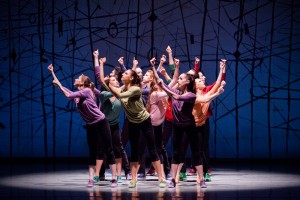The Pennsylvania Ballet presented “Opus Jazz,” the final program of its 2011-12 season, the weekend of June 1 at the Merriam Theater. The show ran for three evenings and two matinee performances and featured a trio of vastly varied dances, including a world premiere.
The Sunday matinee performance began with the “Barber Violin Concerto,” a New York City Ballet original. Featuring a rich royal blue backdrop and dancers clad in flowing white, the spirited ballet offered three distinct phases. The first, a sensuous pas de deux, coupled all four dancers as they emerged in short solos. The couples demonstrated absolute trust in each other as James Ihde and Ian Hussey tossed their partners into challenging lifts, including one that involved a breathtaking flip.
Following this first movement was a sensual duet between Ihde and Amy Aldridge, a Pennsylvania Ballet principal. Aldridge executed graceful extensions in this classic dance, which was performed in pointe shoes.
The final movement, a modern number, saw Hussey and Laura Bowman in bare feet. Bowman arguably stole the show with a youthful, ebullient skip dedicated to shaking her partner out of his stoic resolve. The piece signified a true free spirit in Bowman, who kicked and vamped for “Hussey” with a joie de vivre evocative of Audrey Hepburn’s kicky beatnik dance in “Funny Face.” The audience was visibly and audibly delighted by this number, and it received the loudest applause of the afternoon and brought some patrons to their feet.
After a brief intermission, “Opus Jazz” shifted in an entirely new direction. “Beside them, they dwell” is a world premiere piece created by the ballet’s choreographer in residence Michael Neenan, who was inspired for at least the work’s title by Psalm 104: “They give drink to all the beasts of the field; the wild asses quench their thirst. On their banks dwell the birds of the heaven; from the branches they sing their song.” The piece is highly stylized to reflect creatures of the wild in its movements and aesthetics.
The dancers were bedecked in rich, deep colors and tight costumes of short length, which served to accentuate their flittering movements. The dance was a contrast of fluidity and rigidity, with windmill-like arms giving to robotic poses that would remind one of a jewelry box ballerina.
The stage lighting and music served to create a specific, eerie mood. The stage lights progressed from a deep crimson to cyan and blue as the set roamed on. The music, Pierre Boulez’s “Anthemes II,” also has a biblical tie; the instrumental’s structure is based on the readings of the Jeremiah Lamentations during the composer’s childhood churchgoings. The composition, frantic and metallic, set a hurried pace for the dance. Abrupt and extended silent pauses only added to the tension. The number was decidedly intimate, with synchronized segments displaying the connection between partners, the use of shadow as dancers strode behind a screen in silhouette, and dancers moving in huddled formations like herds of animals. Though a symbolic and artistic piece, the number did not seem to resonate with the audience as well as those before and after it.
The final performance of the trio, Jerome Robbins’ “NY Export: Opus Jazz,” is the titular dance of this presentation of the Pennsylvania Ballet. Robbins, who passed away in 1998, was an internationally renowned choreographer best known for his work on the iconic stage production of “West Side Story.” “Jazz,” which premiered in 1958, opened with a vibrant, title-clad screen, which gave way to a Jackson Pollock-esque backdrop as dancers emerged in vividly hued shirts and matching sneakers, a surprising choice for a ballet.
With a stark white light basking the stage, the dancers erupted into an effervescent, jaunty dance that included a brief circle dance — which was featured in the prior two acts — and shimmies and snaps that lent the piece the blend of fun and cool found in a commercial for Gap. After taking up most of the square footage of the stage, the dancers zoomed into a lit huddle on a blackened stage, creating a discernible jazz vibe.
The next portion of “Opus Jazz” featured a burgundy stage with black backdrop, where the slinky Evelyn Kocak seduced three male dancers in the dusky “Statics” that concluded with her being unceremoniously tossed off the stage.
“Improvisations,” an amusing boogie, portrayed young men and women taking turns creating dances with their peers. While some soloed, others recruited their pals, including four male dancers, in a silly and sometimes feminine group dance that ended with a sweet, stylistic handshake. “Passage for Two,” according to an article by principal dancer Julie Diana featured in the performance program, “suggests an intimate encounter between two people who meet, dance and then part ways.”
Lauren Fadeley, who recently starred as Wendy in the Ballet’s production of “Peter Pan,” and partner Francis Veyette imbued a sadness in their pas de deux, or lover’s dance. The meaning of the piece was evident, and Fadeley’s defeated perch on the stage at the end of the piece remained powerful long after the final curtain.
The fifth and final part of “Opus Jazz” featured the company in “Theme, Variations and Fugue.” The dancers, now clad in white shirts and sneakers, leaped and posed in styles at times reminiscent of swing dance, the twist and even Monty Python’s “Ministry of Silly Walks.” Body isolation abounded, where dancers moved one limb at a time while others remained stationary, a seemingly nonchalant yet hypercontrolled act.
Staged in front of dazzling stained-glass scenery, the equality of the dancers was made apparent; both men and women shook and stretched in clusters of women and clusters of men. Robbins chose to pit the genders as partners in this dance, a refreshing vision that allowed the entire company a chance to shine.
As the dancers re-emerged for their lengthy bows with winded yet smiling faces, it was apparent that they felt they had fully claimed their chance to shine.


